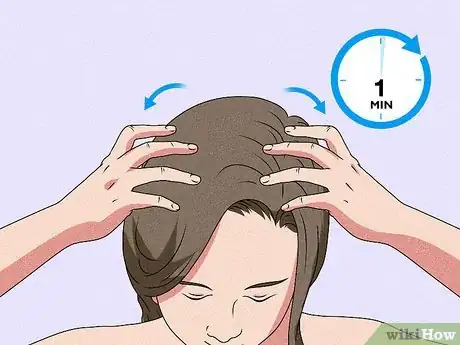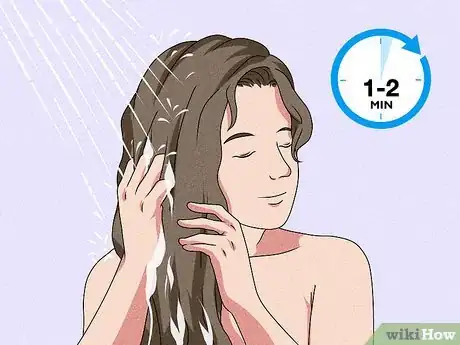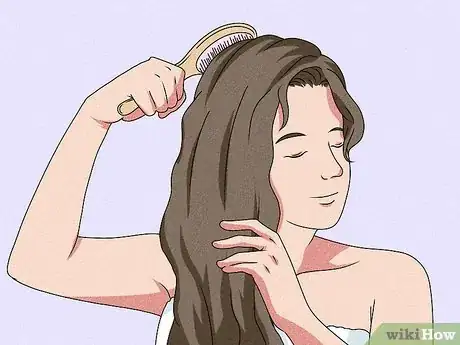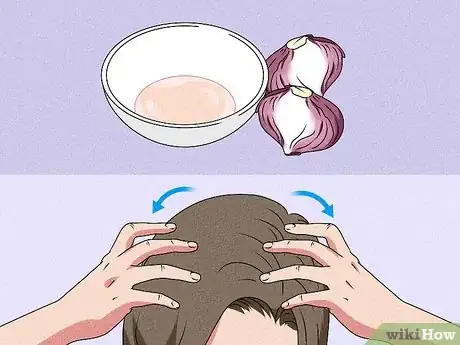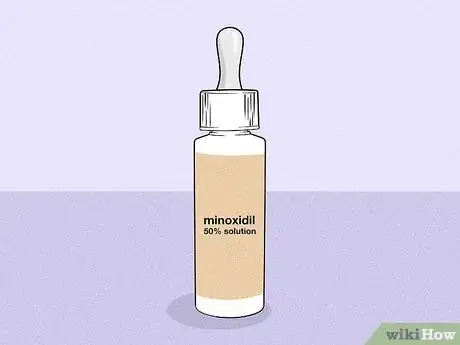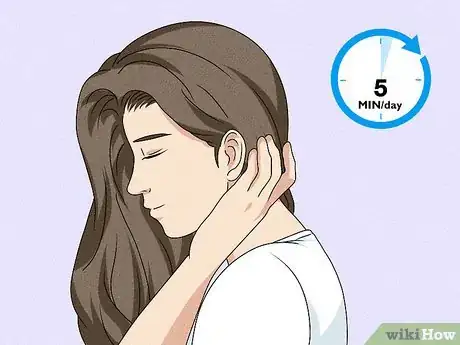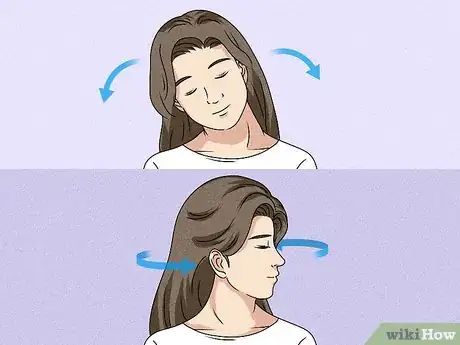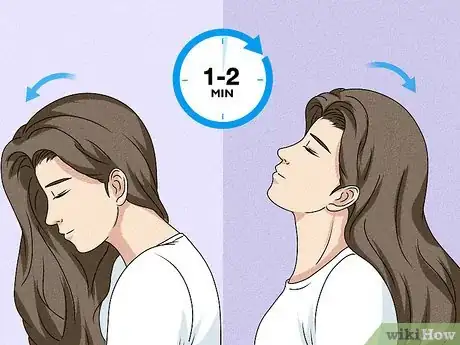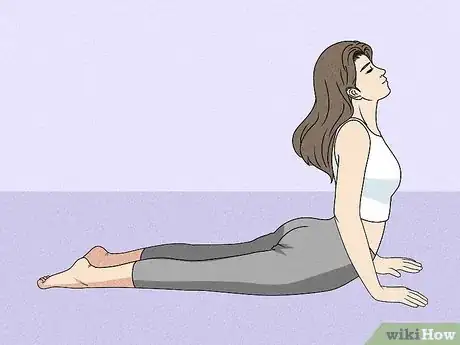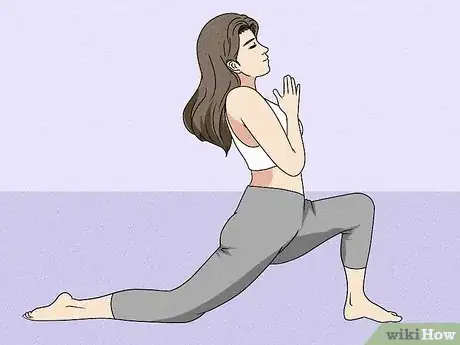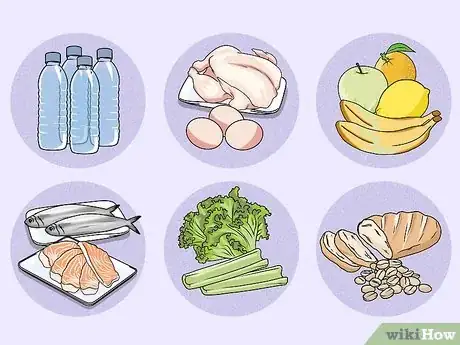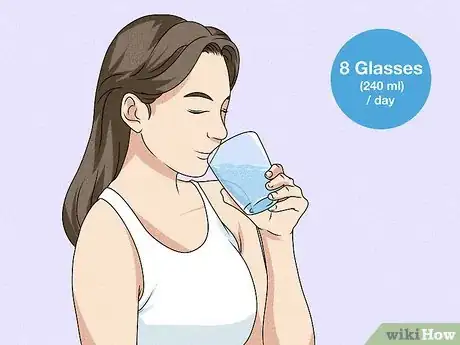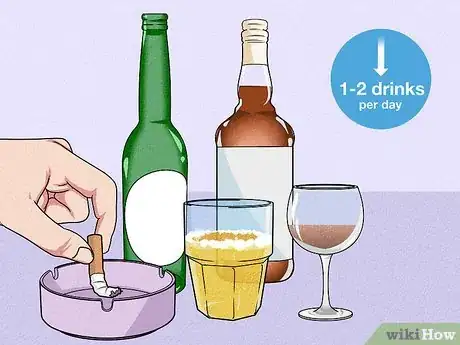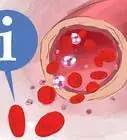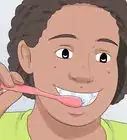This article was co-authored by Luba Lee, FNP-BC, MS and by wikiHow staff writer, Hunter Rising. Luba Lee, FNP-BC is a Board-Certified Family Nurse Practitioner (FNP) and educator in Tennessee with over a decade of clinical experience. Luba has certifications in Pediatric Advanced Life Support (PALS), Emergency Medicine, Advanced Cardiac Life Support (ACLS), Team Building, and Critical Care Nursing. She received her Master of Science in Nursing (MSN) from the University of Tennessee in 2006.
There are 19 references cited in this article, which can be found at the bottom of the page.
This article has been viewed 44,723 times.
If you have frequent headaches or notice that you’re shedding more hair than normal, you may have poor blood flow in your scalp. Not to worry—we’ve got you covered. We’re here to walk you through plenty of simple techniques, at-home remedies, and lifestyle adjustments that you can use to help improve your circulation.
Steps
Massage your scalp.
-
A scalp massage may help increase your blood circulation. Start by putting diluted essential oil on your scalp for 10 minutes before washing it out.[1] X Research source Then, run your fingers over your scalp using light pressure for 1 minute. Deepen the massage by rubbing your knuckles in circular motions toward the center of your scalp for 2-3 minutes.[2] X Research source Finish up by pulling the ends of your hair away from your head for 1 minute.[3] X Research source
- Avoid using undiluted essential oil since it’s too concentrated to use on its own. Similarly, avoid using only carrier oils since they won’t produce the same hair growth results.[4] X Trustworthy Source PubMed Central Journal archive from the U.S. National Institutes of Health Go to source
- Lavender, rosemary, and peppermint oils all work great to help with hair growth and reduce hair loss.[5] X Trustworthy Source PubMed Central Journal archive from the U.S. National Institutes of Health Go to source
- If it hurts too much to apply pressure with your knuckles, use your fingertips to massage your head.
- Use an electric scalp massager if you don’t want to do it by hand. You can buy scalp massagers online or from home good stores.
Run cold water over your scalp.
-
Pouring cold water over your scalp for 1–2 minutes can improve circulation. Turn the shower to the coldest temperature you can handle and let it run over your scalp. Rinse your scalp for at least 1–2 minutes at a time. Rub your scalp with your fingertips while you’re rinsing it in the shower to help promote better circulation and feel more relief.
- Cold water helps widen your blood vessels so more blood flows through your scalp.
- If you can’t handle a full cold shower, keep the water hot while you wash your body and turn it cold only when you wash or rinse off your head.
- You could also try doing a contrast shower, where you alternate between 10-second intervals of warm and cool water.
Brush your hair for a few minutes each day.
-
A brush with stiff, natural bristles can really stimulate your blood vessels. If you have long or tangled hair, start brushing near the ends and work your way up toward the roots. If you have short hair, work from the center of your scalp toward the ends. Apply light pressure to get the most effective results.
- Brushing your hair lightly tugs your scalp, which can help widen blood vessels and improve your circulation.
Put raw onion juice on your scalp 3 times a week.
-
Raw onion juice may help with hair regrowth.[6] X Research source Chop half of a fresh onion and squeeze it tightly into a bowl to separate the solid pieces from the juice. Rub the onion juice directly onto your scalp and massage it in with your fingertips. Allow the raw onion juice to sit on your scalp for about 30 minutes before washing it out with shampoo.
- You may also buy pre-squeezed onion juice from your local grocery store.
Tip: If your hair still smells like onions, combine equal parts water and white vinegar, and use it to rinse your hair before you shampoo it.
Use minoxidil if you’re also experiencing hair loss.
-
Minoxidil boosts hair growth and improves the structure of your blood vessels.[7] X Trustworthy Source National Institutes of Health U.S. government agency for biomedical and public health research Go to source Look for a topical minoxidil foam or solution, and read the directions carefully. Start applying a single dose in the center of your scalp and work it toward the sides. Wash your hands immediately after applying the minoxidil, and avoid washing your scalp for 4 hours after application. Let the treatment dry completely, which takes about 2–4 hours.[8] X Trustworthy Source Mayo Clinic Educational website from one of the world's leading hospitals Go to source
- You can get minoxidil at your local pharmacy or online. You may also get prescription-strength varieties from your doctor.
- If you experience inflammation, rashes, or swelling, stop using minoxidil and talk to your doctor.
- Studies have shown rosemary oil is as effective as minoxidil in increasing hair growth.[9] X Trustworthy Source PubMed Central Journal archive from the U.S. National Institutes of Health Go to source
Rub the back of your scalp twice a day for 5 minutes.
-
This exercise may help increase circulation around your scalp. Lace your fingers behind your head and press your thumbs into the ridges on the back of your neck. Apply firm pressure to the back of your head and move your hands up and down to move your scalp. Rub the back of your scalp for 2–3 minutes before moving your hands to the sides of your head. Press down on the sides of your head for another 2–3 minutes.[10] X Research source
- These exercises are especially helpful to increase blood flow after a hair transplant, but they will still improve your circulation.
Roll your neck around your shoulders.
-
This helps blood circulate through your head. Slowly tilt your head toward your left shoulder so your ear is almost touching it. Roll your down so your chin touches your chest, and continue moving it around to the right shoulder. Keep moving your head in a clockwise direction for 2–3 full rotations before switching directions.[11] X Research source
- Avoid tilting your neck too far back behind your head since it could make you feel uncomfortable.
Tilt your head upside-down for 1-2 minutes.
-
This helps get blood flowing to your scalp. Lay down on a bed or couch so your shoulders hang over the edge. Plant your hands on the floor and slowly lower your upper body until your head is upside-down. Continue holding yourself in this position for about 1–2 minutes so blood rushes to your head and widens the blood vessels in your scalp. Repeat this process once daily.
- Sit up immediately if you start feeling dizzy or experiencing neck pain.
- If you can afford it, try using an inversion table that you can lay on and tilt your entire body upside-down.
Practice yoga to stretch your neck and your back.
-
Yoga can help increase blood flow. Search for poses that help you focus on your neck and upper back since they will help you increase blood flow to your head the most. For a simple downward dog pose, keep your feet firmly planted on the ground and bend at the hips at a 90-degree angle. Place your hands flat on the ground so your head is upside-down. You can also lie on your stomach and straighten your arms to bend your back to try a cobra pose.
- You can also do standard yoga poses to help increase blood circulation throughout your entire body.
- If you want more advanced poses, try doing handstands or inversions.
Work out for 150 minutes each week.
-
This helps improve circulation all over your body. Aim to do aerobic exercises for 30 minutes daily for at least 5 days out of the week. Try walking, running, and lifting weights to improve your heart health and keep your circulatory system working properly. Work out different muscles groups, like your arms, legs, chest, back, and core, each day so you don’t get too fatigued throughout the week.[12] X Trustworthy Source MedlinePlus Collection of medical information sourced from the US National Library of Medicine Go to source
- Be sure to stretch before and after you exercise since it can also help improve your circulation.
Stick with loose, comfortable hairstyle.
-
Wearing tight hairstyles for long periods of time creates tension on your scalp. This, in turn, can affect your circulation. Keep your hair down or in a loose, relaxed style so you’re less likely to affect your scalp or hair health.[13] X Trustworthy Source PubMed Central Journal archive from the U.S. National Institutes of Health Go to source
Maintain a healthy and balanced diet.
-
Nutritious foods can help boost your circulatory system. Opt for leafy greens, fruits, and vegetables so you get vitamins and minerals that help improve your circulatory system. Choose healthy fats, such as oily fish, nuts, lean meats, and avocado, since they’re unsaturated and less likely to cause blood clots. Try your best to avoid sugary foods, trans and saturated fats, and simple carbs, since they don’t have as much nutritional value.[14] X Trustworthy Source PubMed Central Journal archive from the U.S. National Institutes of Health Go to source
- Rather than snacking on chips or sugary sweets, choose pieces of fruit, vegetables, or low-fat alternatives.
- Take a daily multivitamin if you’re worried about not getting the proper nutrients from your food.
Drink water regularly.
-
Staying hydrated helps regulate your blood flow. Do your best to limit sugary drinks since they could dehydrate you more and make your circulation worse over time.[15] X Trustworthy Source Harvard Medical School Harvard Medical School's Educational Site for the Public Go to source
- Keep track of the fluids you drink each day so you’re able to see how much water you’re drinking.
- If you have trouble remembering to drink water, look for apps on your phone that remind you when to rehydrate.
Quit drinking alcohol or smoking.
-
Tobacco and alcohol can stress your blood vessels. With this in mind, do your best to limit how often you have them. Look for smoking cessation products to help you get rid of any urges. If you drink alcohol, limit yourself to 1–2 drinks per day so you don’t cause any lasting damage to your body.[16] X Trustworthy Source PubMed Central Journal archive from the U.S. National Institutes of Health Go to source
- Look for support groups in person or online if you have trouble quitting on your own.
- Try asking your doctor for prescription-strength cessation products to help you even more.
Check your vision to prevent eye strain.
-
Straining to see can cause tension around your scalp and limit your circulation. If you’re struggling to see, get an eye exam to see if you need a new prescription.[17] X Research source
Try progressive relaxation.
-
Try this exercise for a few minutes at a time to help keep your blood flowing. Pay attention to your posture and if you’re holding tension in your face while you go about your day. If you’re feeling tense, consciously take the time to relax the muscles in your face throughout the day. Try it for a few minutes at a time to help keep your blood flowing.[18] X Trustworthy Source PubMed Central Journal archive from the U.S. National Institutes of Health Go to source
Warnings
- Talk to your doctor if you get severe or frequent headaches since they may be signs of more serious conditions.[20] X Trustworthy Source Mayo Clinic Educational website from one of the world's leading hospitals Go to source⧼thumbs_response⧽
You Might Also Like



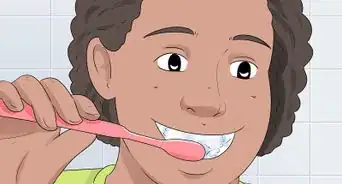



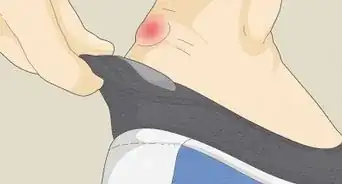 Blood Blister Treatment Plus Causes and When to See a Doc
Blood Blister Treatment Plus Causes and When to See a Doc
-Step-14-Version-2.webp)
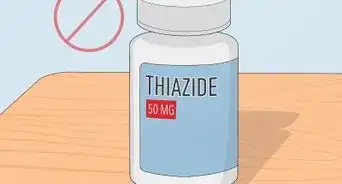 Increasing Low Blood Sodium: At-Home and Medical Options
Increasing Low Blood Sodium: At-Home and Medical Options


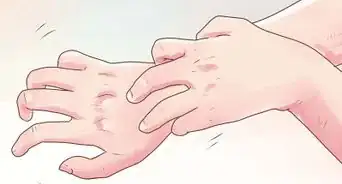
 How to Use a Wrist Blood Pressure Cuff
How to Use a Wrist Blood Pressure Cuff
References
- ↑ https://verilymag.com/2017/11/immediate-benefits-daily-scalp-massage-with-essential-oils
- ↑ https://www.webmd.com/balance/stress-management/features/massage-therapy-stress-relief-much-more
- ↑ https://youtu.be/qKdAC1EuiCs?t=91
- ↑ https://pubmed.ncbi.nlm.nih.gov/9828867
- ↑ https://pubmed.ncbi.nlm.nih.gov/9828867
- ↑ https://www.webmd.com/skin-problems-and-treatments/hair-loss/ss/slideshow-alternative-treatments-for-hair-loss
- ↑ https://www.nih.gov/news-events/nih-research-matters/minoxidil-may-improve-blood-vessel-structure
- ↑ https://www.mayoclinic.org/drugs-supplements/minoxidil-topical-route/proper-use/drg-20068750
- ↑ https://pubmed.ncbi.nlm.nih.gov/25842469/
- ↑ https://www.youtube.com/watch?v=-4cangTFUx4
- ↑ https://www.nytimes.com/1986/09/28/magazine/relieving-stress-mind-over-muscle.html
- ↑ https://medlineplus.gov/benefitsofexercise.html
- ↑ https://www.ncbi.nlm.nih.gov/pmc/articles/PMC4560210/
- ↑ https://www.ncbi.nlm.nih.gov/pmc/articles/PMC6356661/
- ↑ https://www.health.harvard.edu/newsletter_article/is-blood-like-your-waistline-the-thinner-the-better
- ↑ https://www.ncbi.nlm.nih.gov/pubmed/18468640
- ↑ https://americanmigrainefoundation.org/resource-library/do-i-need-to-have-my-eyes-checked-if-my-head-hurts/
- ↑ https://www.ncbi.nlm.nih.gov/pmc/articles/PMC3193654/
- ↑ https://health.clevelandclinic.org/can-wearing-a-hat-make-you-go-bald/
- ↑ https://www.mayoclinic.org/symptoms/headache/basics/when-to-see-doctor/sym-20050800
About This Article

